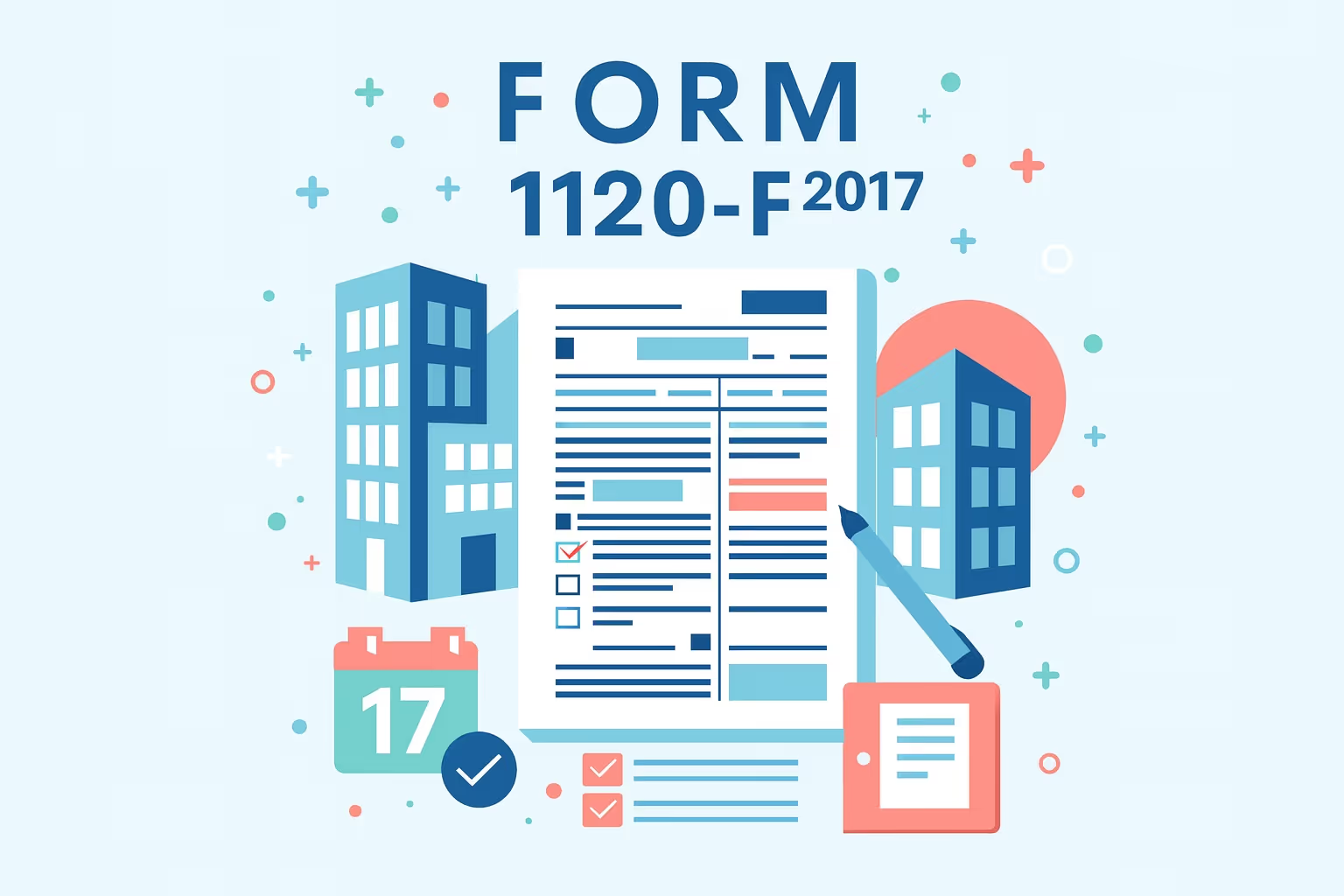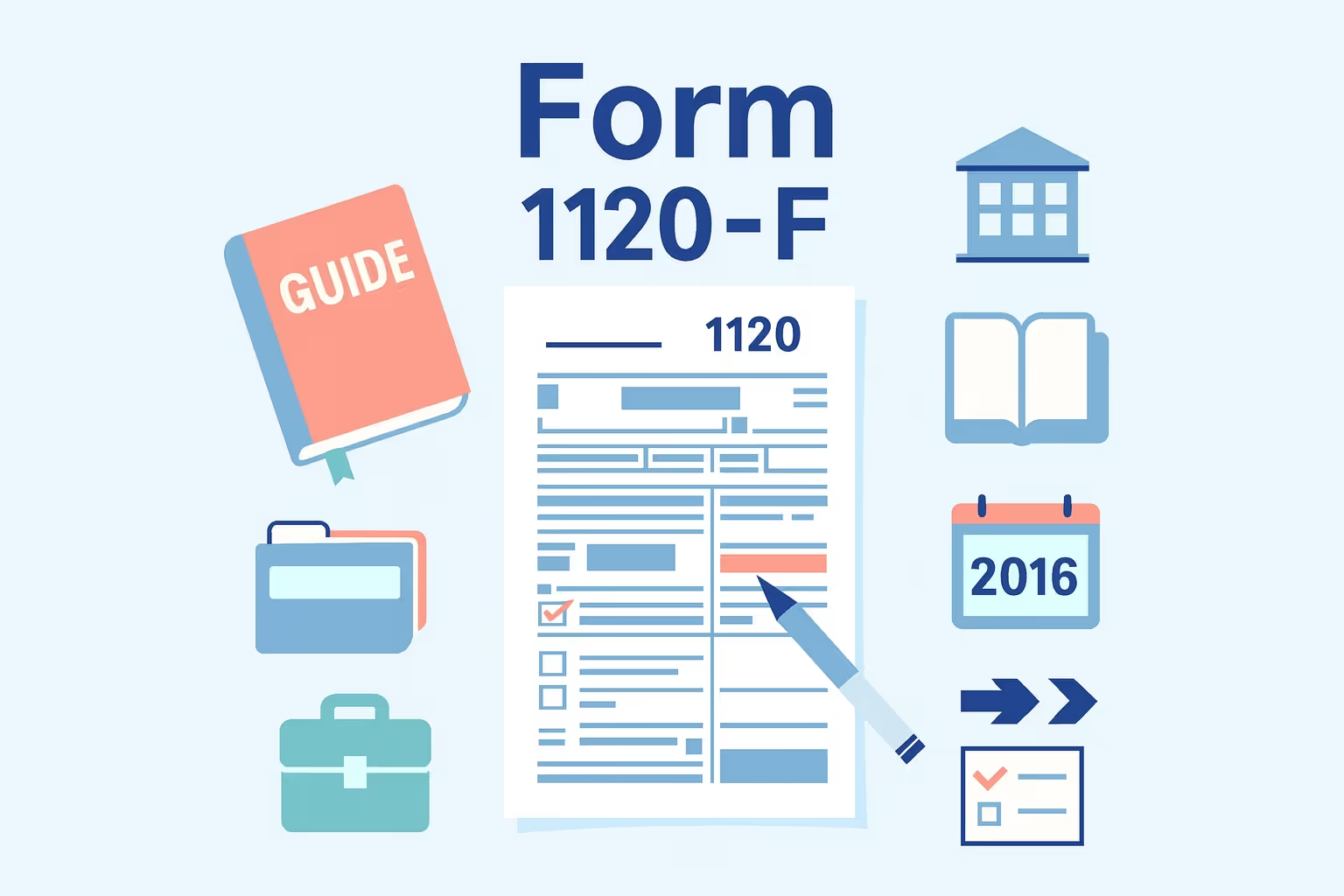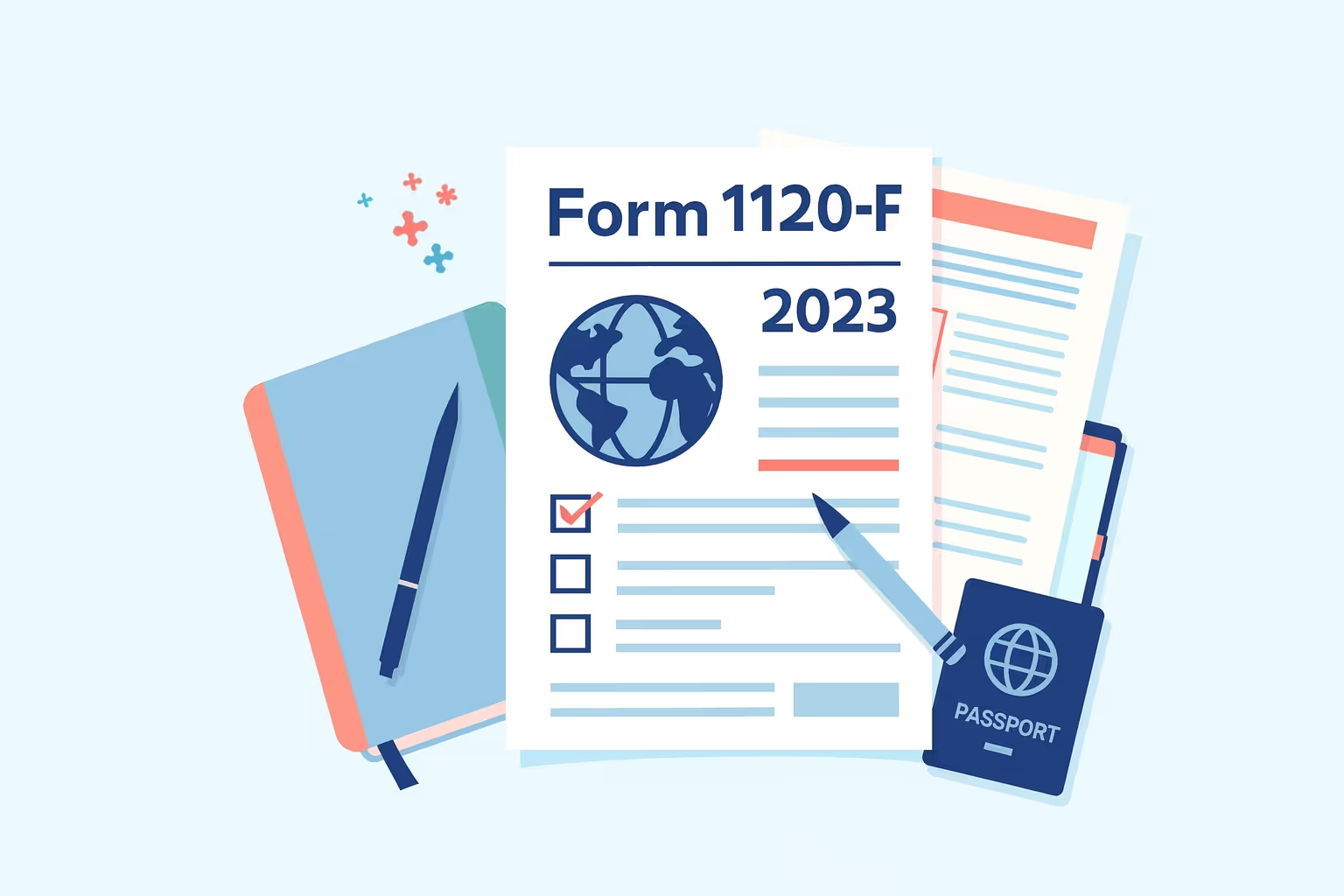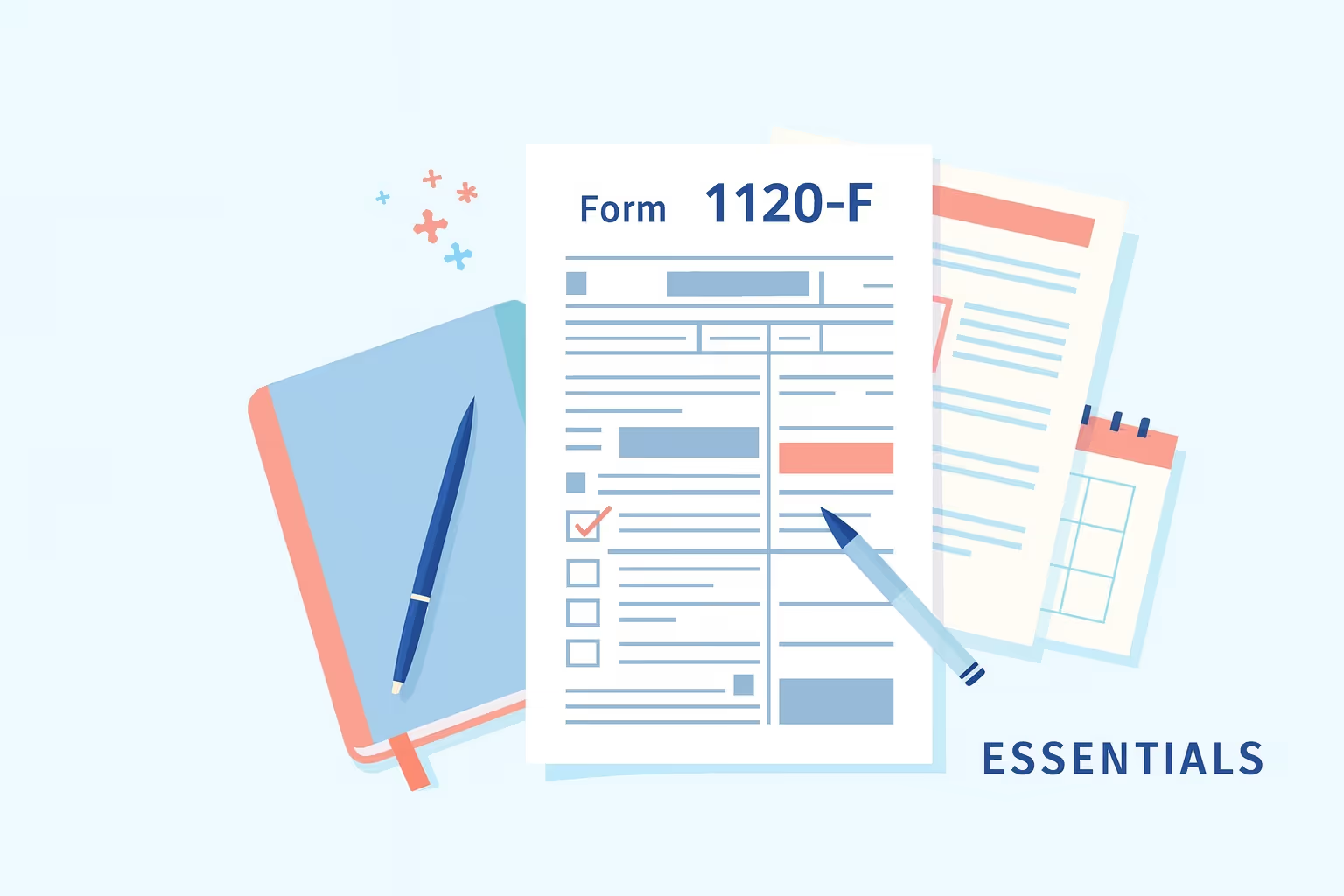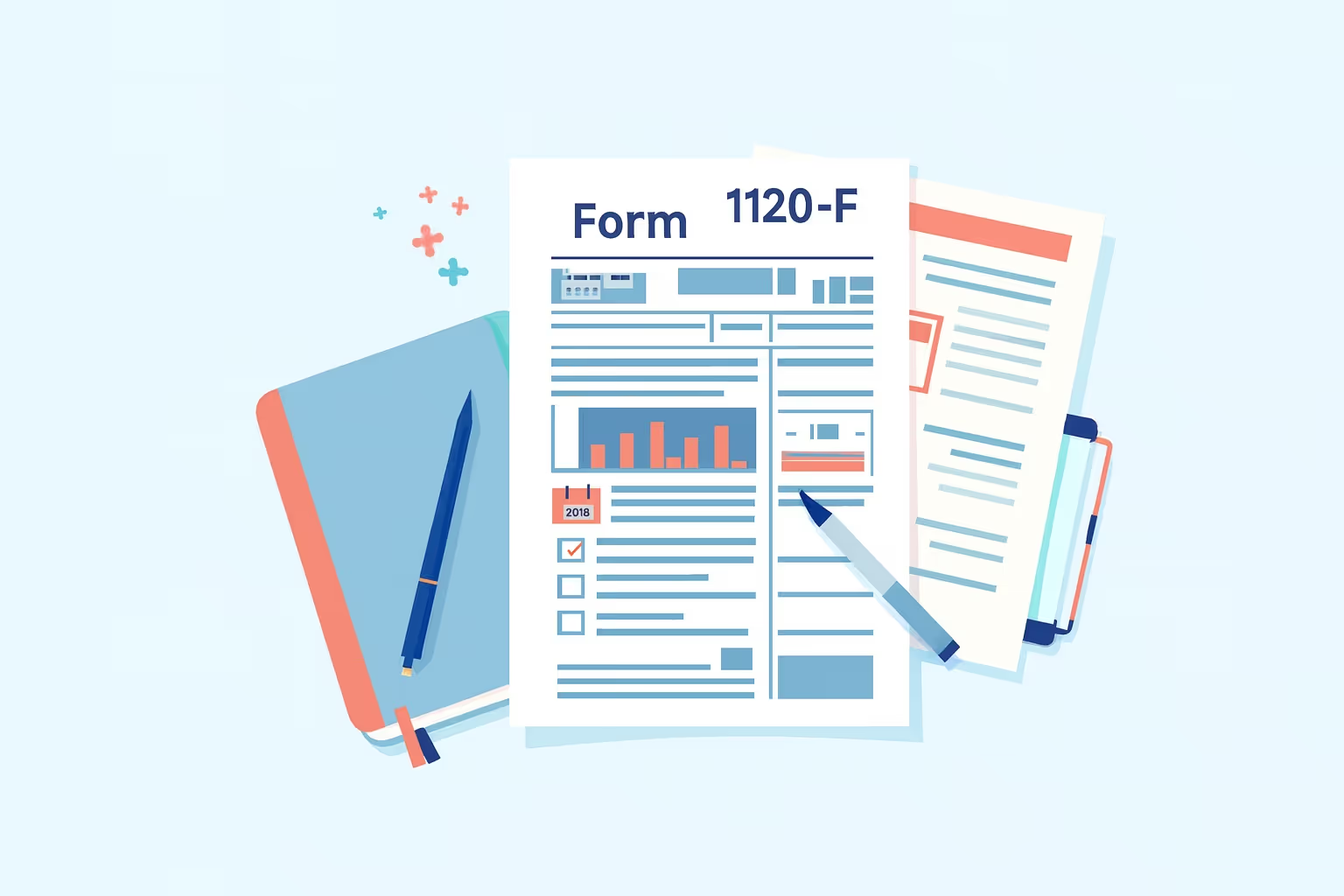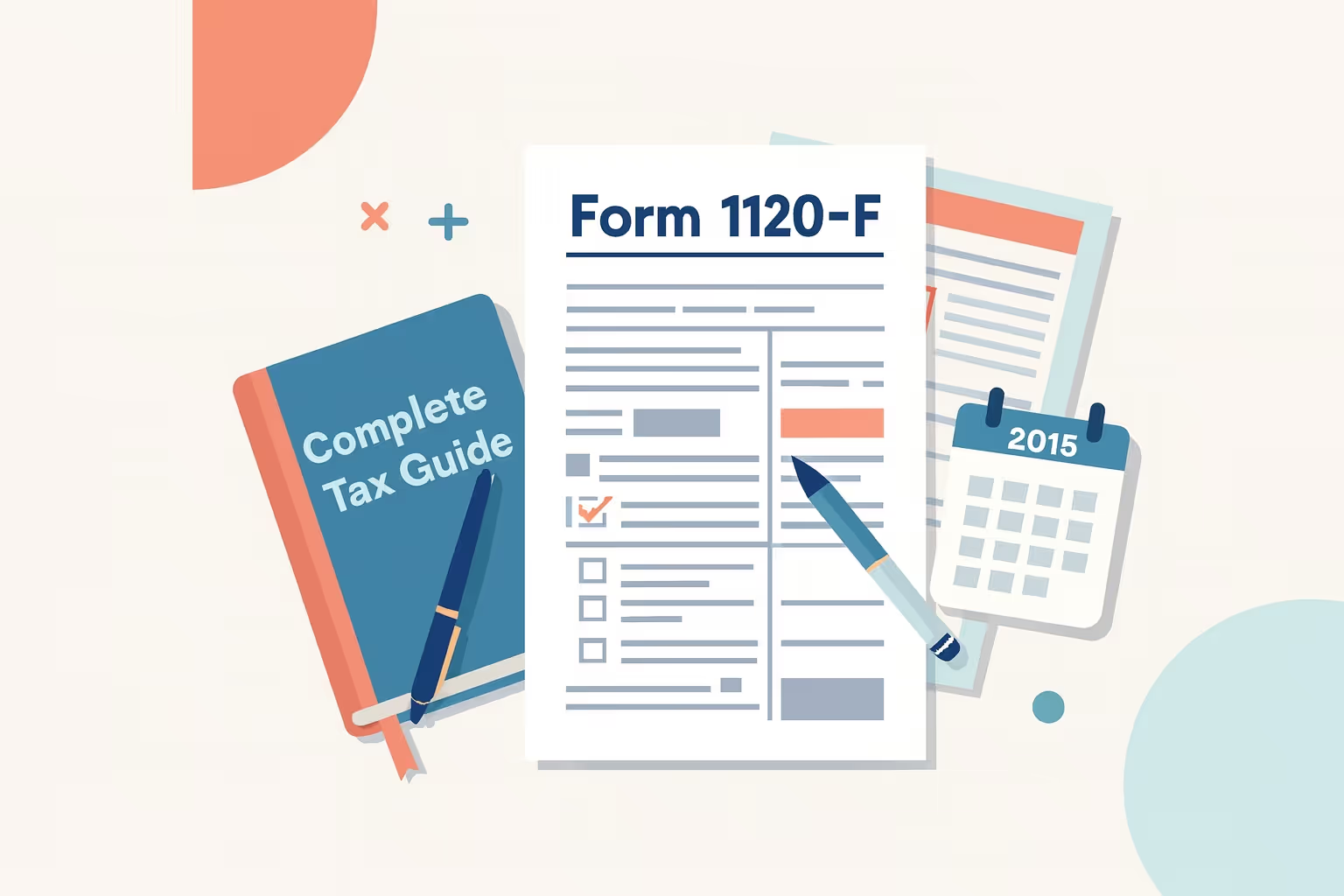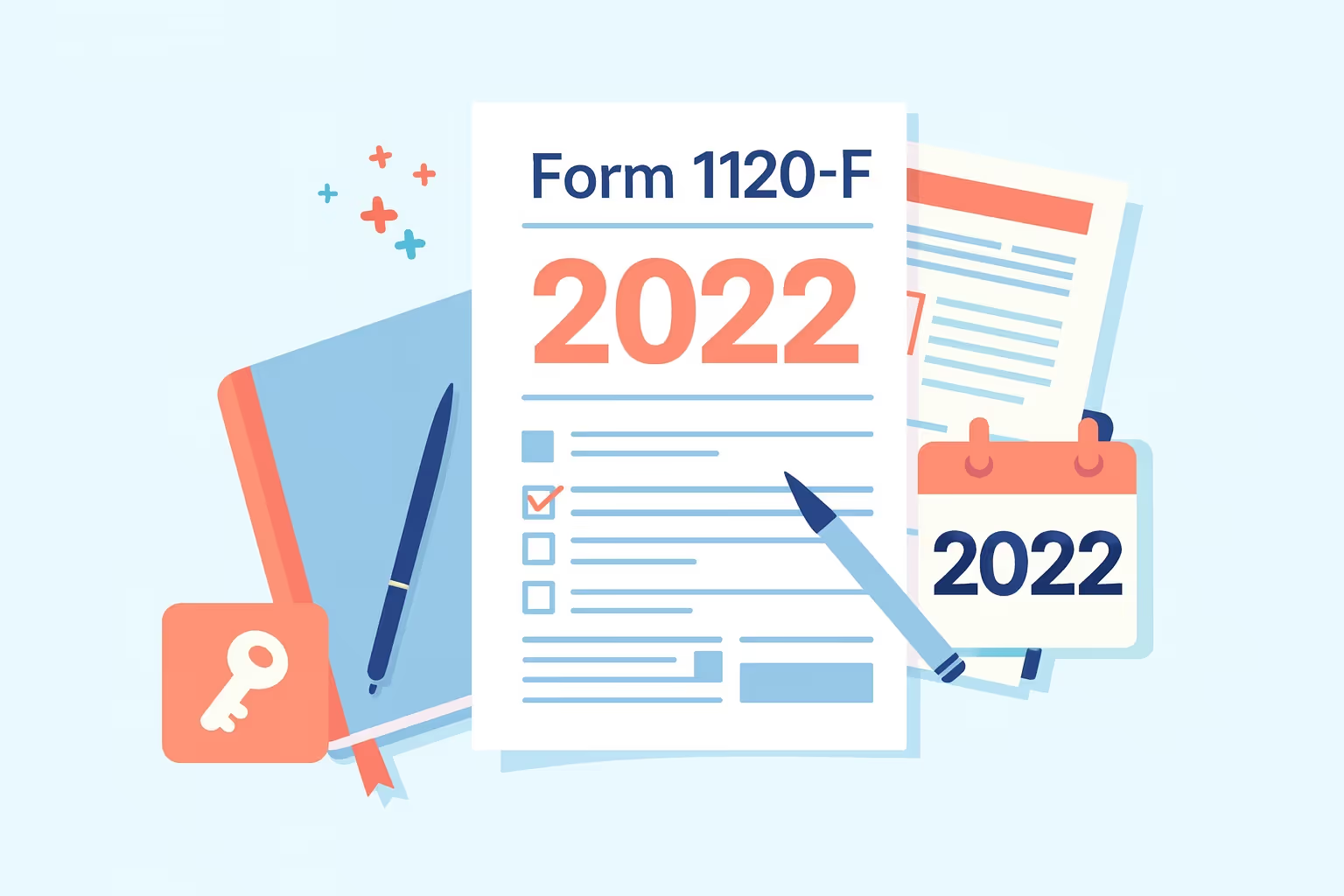
Form 1120-F is the U.S. Income Tax Return of a Foreign Corporation, used for reporting income, deductions, credits, and tax liability. For the 2014 tax year, foreign corporations engaged in trade or business within the United States, or those with effectively connected income, must follow specific filing requirements outlined by the IRS. The form ensures that corporations correctly determine taxable income, apply applicable tax treaties, and calculate any branch profits tax owed.
Foreign corporations are required to file even if no tax is due. Filing protects their ability to claim deductions and tax credits, and it documents their business activities for tax purposes. Companies may also need to disclose treaty-based positions, address capital gains, and allocate interest expense. Missing the original due date, whether in the fourth or sixth month after the close of a fiscal year, can result in penalties. Extensions are possible through Form 7004, but payments must still be made by the legal holiday or next business day deadline.
Understanding the instructions on Form 1120-F 2014 is essential for corporations to remain compliant. Filing requirements may differ from those of domestic corporations, especially when foreign persons or parent corporations are involved. This guide provides step-by-step instructions, explains how to pay taxes, and highlights common mistakes that can occur during the process. It is designed for taxpayers unfamiliar with U.S. regulations, making complex rules accessible and ensuring corporations meet their tax obligations efficiently.
Overview of the 2014 Arizona State Tax Return
The Arizona state tax return is the form used by individuals and corporations to report income earned during the tax year and to calculate the amount of state income tax owed. For 2014, taxpayers were required to follow specific filing instructions to ensure that taxable income, deductions, and any applicable credits were reported accurately. The Arizona Department of Revenue establishes the filing rules, deadlines, and payment options for both residents and nonresidents.
Who Must File?
- Residents, part-year residents, and nonresidents with Arizona-sourced income are required to file an Arizona state tax return.
- Corporations with business income, capital gains, or other taxable income are also required to submit a return to the state.
What Income Is Reported?
- Taxpayers must include all sources of gross income, such as wages, dividends, capital gains, and other business income.
- Specific adjustments may apply depending on the taxpayer’s business activities, trade, or ownership of real property interests in Arizona.
Deductions and Credits
- Taxpayers are permitted to claim deductions for allowable expenses, including charitable contributions.
- Credits may also be applied, such as the credit for taxes paid to another state or the foreign tax credit when applicable.
Deadlines and Extensions
- The original due date for most taxpayers is the 15th day of the fourth month following the close of the tax year.
- If the due date falls on a weekend or legal holiday, the next business day becomes the filing deadline.
- Extensions are available, but an extension applies only to filing and does not extend the time to pay taxes owed.
This overview highlights the essential features of the Arizona state return for 2014, giving taxpayers and corporations the necessary context before proceeding to the step-by-step filing details.
Who Must File Form 1120-F?
Foreign corporations are required to file Form 1120-F if they are engaged in trade or business activities within the United States. This requirement applies even when no income tax is ultimately due, since filing preserves the right to claim deductions and credits. Filing is also necessary when corporations seek to benefit from an income tax treaty.
Filing Triggers
Foreign corporations must file Form 1120-F when they earn U.S. source income such as wages, dividends, interest, or capital gains. Filing is also required when a corporation has effectively connected business income from U.S. trade, services, or real property interests.
In addition, foreign corporations that intend to claim deductions, apply tax credits, or take advantage of reduced rates under tax treaties must file. Parent corporations or parent companies that hold U.S. subsidiaries or branch operations are also required to submit Form 1120-F.
Filing Deadlines
The deadline to file depends on whether the corporation maintains a U.S. office. If a U.S. office exists, the return must be filed by the 15th day of the fourth month following the close of the tax year. If there is no U.S. office, the deadline extends to the 15th day of the sixth month following the month the notice is received.
When the due date falls on a weekend or legal holiday, the IRS allows the return to be filed on the next business day. Corporations operating on a fiscal year should note that the original due date shifts according to the chosen accounting period.
What’s New for Tax Year 2014?
For the 2014 tax year, several updates affected foreign corporations filing Form 1120-F. These updates included new electronic filing rules, expanded reporting requirements, and stricter standards for treaty disclosure.
Electronic Filing Requirements
The Internal Revenue Service required corporations with total assets of $10 million or more that file at least 250 returns in a year to file Form 1120-F electronically. This mandate was designed to enhance the accuracy of returns, minimize common errors, and expedite processing times for both taxpayers and the IRS.
Schedule M-3 Requirement
Corporations with total assets of at least $10 million were also required to use Schedule M-3 instead of Schedule M-1. This expanded schedule provides a more detailed reconciliation between a corporation’s financial statement income and taxable income reported for U.S. tax purposes.
Treaty-Based Return Positions
Foreign corporations claiming benefits under an income tax treaty needed to attach Form 8833 to disclose treaty-based return positions. The IRS imposed a $10,000 penalty for failing to provide this disclosure when required, emphasizing the importance of compliance with international tax reporting rules.
Step-by-Step Filing Instructions
To correctly complete Form 1120-F, foreign corporations must carefully prepare the necessary documentation, complete the form sections in sequence, and apply the proper tax treatment to their income. Following a structured process helps prevent errors and ensures compliance with IRS regulations.
1. Gather Required Information.
Before completing the form, corporations must collect all necessary documentation. This includes an Employer Identification Number (EIN), incorporation documents from the country of origin, and records of U.S. trade or business activities.
They should also gather financial statements prepared per U.S. GAAP or their home country's standards, along with documentation on related-party transactions and applicable tax treaties. Copies of prior-year tax returns and withholding certificates should also be reviewed and kept on file for future reference.
2. Complete Header Information.
The top portion of Form 1120-F requests basic identifying details. Corporations must enter their legal name, EIN, country of incorporation, and the principal business activity code. Special checkboxes must also be reviewed and marked when appropriate, including boxes for an initial return, a protective return, or a Schedule M-3 filing.
3. Report FDAP Income.
Corporations must disclose any Fixed, Determinable, Annual, or Periodical (FDAP) income earned from U.S. sources. FDAP income typically includes dividends, interest, rents, and royalties. This type of income is generally subject to a 30 percent tax rate; however, an income tax treaty may allow for a reduced rate. No deductions are permitted against FDAP income, so corporations must report the full gross amount.
4. Report Effectively Connected Income.
Corporations engaged in U.S. trade or business must report effectively connected income (ECI) in this section. ECI includes business income from sales or services, as well as capital gains linked to U.S. business activities. Unlike FDAP income, ECI allows deductions. Corporations may deduct expenses, such as wages, compensation, interest expenses, and other business costs, to determine their taxable income.
5. Calculate Branch Profits Tax.
Foreign corporations with U.S. operations may also be subject to the branch profits tax. This tax is calculated by identifying effectively connected earnings and profits, then determining the dividend equivalent amount. Once this figure is established, the 30 percent branch profits tax rate applies, unless a reduced rate is available under an applicable tax treaty.
By carefully following these steps, corporations ensure that their gross income, total deductions, and tax liability are correctly reported. This process reduces the risk of penalties and helps corporations comply with IRS requirements for the 2014 tax year.
How to File Form 1120-F?
Foreign corporations may choose to file Form 1120-F either electronically or by paper, depending on their size and filing obligations. The IRS strongly recommends electronic filing, especially for corporations with extensive asset holdings.
Electronic Filing
Electronic filing provides several advantages. It reduces the likelihood of errors by validating entries before submission and provides faster acknowledgment of receipt from the IRS. Corporations required to e-file must use an authorized provider.
Those with $10 million or more in assets and at least 250 returns are also required to comply. A signed Form 8453-I, U.S. Corporation Income Tax Declaration for an IRS e-file Return, must accompany electronic submissions.
Paper Filing
Paper filing remains an option for corporations that are not mandated to e-file. Paper returns must be mailed to the IRS Service Center in Ogden, Utah. Corporations should use certified mail with a return receipt to verify timely submission.
Signatures must be original, and all attachments should be included in full. Retaining copies of the return and supporting schedules is strongly recommended. Electronic filing is generally considered the most efficient and secure option, but corporations must select the method that best suits their circumstances and complies with IRS regulations.
Payment Instructions
Foreign corporations are required to pay taxes by the original due date of the return, regardless of whether they receive an extension for filing. Payments may be made electronically or by check.
Payment Due Dates
Corporations operating on a calendar year basis must pay by April 15 if they maintain a U.S. office or by June 15 if they do not. For fiscal year corporations, payments are due on the 15th day of the fourth month (if a U.S. office is present) or the 15th day of the sixth month (if no U.S. office is present). If a deadline falls on a weekend or legal holiday, the next business day applies.
Payment Methods
The IRS accepts multiple payment methods. Corporations may use the Electronic Federal Tax Payment System (EFTPS), Automated Clearing House (ACH) debit or credit, and wire transfer for same-day payments. Checks should be made payable to the United States Treasury and should include the EIN, tax year, and “Form 1120-F” on the memo line.
Estimated Payments
Corporations expecting a tax liability of $500 or more must make estimated payments. These are generally due quarterly, on the 15th day of the fourth, sixth, ninth, and twelfth months of the tax year. Corporations may use Form 1120-W to determine the appropriate amounts. Meeting payment obligations on time helps avoid penalties and ensures corporations remain in compliance with U.S. tax laws.
Required Schedules and Attachments
Form 1120-F requires several schedules and attachments to provide a complete picture of a corporation’s financial activity. The specific schedules depend on the corporation’s assets, income, and type of transactions.
Key Schedules
- Schedule C is used to report dividend income and special deductions. Corporations with dividends from U.S. or foreign sources are required to complete this schedule.
- Schedule D reports capital gains and losses from the sale or exchange of property.
- Schedule H allocates deductions related to effectively connected income, which is required for all corporations engaged in U.S. trade or business.
- Schedule I is used when corporations have interest expense that must be allocated between ECI and non-ECI activities.
- Schedule L provides a balance sheet at the beginning and end of the tax year. This is required unless total receipts and assets are under $250,000.
- Schedule M-1 reconciles book income and taxable income for corporations with assets below $10 million.
- Schedule M-3 is required for corporations with assets of $10 million or more, providing a more detailed reconciliation of assets and liabilities.
- Schedule P is required when the corporation owns interests in partnerships.
Additional Attachments
Corporations may also be required to file forms such as Form 5472 for related party transactions, Form 8833 for treaty-based positions, Form 1118 for foreign tax credits, and Form 8858 for reporting disregarded entities. Supporting statements may include transfer pricing documentation, book-tax reconciliation details, and U.S. net equity computations.
Including the correct schedules and attachments ensures that taxable income, deductions, and credits are reported accurately. This also reduces the risk of IRS inquiries or penalties for incomplete filing.
Common Filing Mistakes to Avoid
Filing Form 1120-F can be complex, and many foreign corporations make mistakes that lead to penalties or processing delays. Understanding the most common errors helps corporations avoid costly issues.
Filing Errors
Many corporations fail to obtain an Employer Identification Number (EIN) before submitting their tax return. Since all corporations are required to have an EIN, filing without one can result in the return being rejected. Another frequent error is misunderstanding the filing deadline. Corporations with U.S. offices must file by the fourth month, while those without an office file by the sixth month. Corporations also sometimes overlook the need for original signatures on paper returns or Form 8453-I for electronic filings.
Calculation Errors
Misclassifying income is a frequent mistake. Corporations sometimes confuse effectively connected income with FDAP income, leading to incorrect tax calculations and missed deductions. Others miscalculate the branch profits tax by failing to properly adjust U.S. net equity or dividend equivalent amounts. Interest expense is also often misallocated between effectively connected and non-effectively connected (ECI) activities.
Documentation Issues
Some corporations fail to attach Form 8833 when claiming treaty benefits, which can result in a $10,000 penalty. Others fail to include Form 5472 for related party transactions or provide incomplete transfer pricing documentation. Missing schedules, incomplete financial statements, or untied reconciliations between Schedule L and the corporation’s records are also standard.
By carefully reviewing instructions and double-checking attachments, corporations can reduce the likelihood of these mistakes and maintain compliance with IRS regulations.
Zero Activity or Dormant Year Returns
A corporation may believe it does not need to file Form 1120-F if it had no U.S. business activities or income during the tax year. However, the IRS requires many corporations to file a return even in years with zero activity.
When Filing Is Required?
Corporations must file if they were previously engaged in U.S. trade or business, even if there is no current activity. Filing is also required if the corporation has U.S. source income, maintains U.S. assets, holds U.S. bank accounts, or engages in transactions with related parties that involve U.S. entities.
When Filing May Not Be Required?
A foreign corporation may not need to file if it has never engaged in U.S. trade or business, had no U.S. source income, and does not maintain U.S. assets or bank accounts. Corporations with no related party transactions involving U.S. entities may also be exempt.
Protective Returns
Corporations uncertain about filing requirements may submit a protective return. This filing preserves the right to claim deductions, apply tax credits, and rely on treaty protections if the IRS later determines that filing was necessary.
Even when no activity occurs, completing the required sections and signing the return helps corporations avoid compliance issues in the future.
First-Time Filer Tips
Corporations filing Form 1120-F for the first time should take extra care to understand filing requirements and maintain accurate documentation. The IRS provides specific steps to help first-time filers stay compliant.
Obtaining an EIN
A foreign corporation must obtain an Employer Identification Number before filing. This is done using Form SS-4, and the process may take several weeks. The EIN is required for all subsequent tax returns and payments.
Establishing Tax Accounting Methods
Corporations must choose a tax year, which can be either a calendar year or a fiscal year, and select an accounting method, such as the cash or accrual method. Establishing these practices early helps ensure accurate reporting and consistent tax treatment of business income, deductions, and expenses.
Preparing Documentation
Corporations must maintain detailed records of their U.S. business activities, including incorporation documents and supporting schedules. First-time filers should carefully document the start date of U.S. trade or business, maintain copies of all withholding certificates, and prepare schedules for allocation and apportionment of expenses.
Considering Professional Help
Because Form 1120-F is complex, many corporations benefit from working with tax professionals who can provide expert guidance and support. Enrolled agents, CPAs with international tax experience, or tax attorneys can help ensure compliance, analyze treaty positions, and provide advice and guidance on transfer pricing.
First-time filers who follow these steps are better positioned to file an accurate return, avoid penalties, and establish good compliance practices for future tax years.
Special Topics
Form 1120-F covers several complex aspects of U.S. taxation that foreign corporations need to understand. Among the most significant are distinguishing effectively connected income from FDAP income and accurately calculating the branch profits tax.
Effectively Connected Income (ECI) vs. FDAP Income
Effectively connected income, or ECI, is income earned from U.S. sources that is directly tied to a corporation’s trade or business activities in the country. This includes business income, rental income from actively managed real property interests, and capital gains from the sale of U.S. business assets. ECI is taxed at regular corporate income tax rates, and corporations are permitted to claim deductions for expenses such as wages, interest, and business costs.
Fixed, Determinable, Annual, or Periodical (FDAP) income, on the other hand, typically comprises passive income, including dividends, portfolio interest, royalties, and annuities. FDAP income is subject to a flat 30 percent withholding tax, although tax treaties may reduce this rate. Unlike ECI, FDAP income does not allow deductions. Correctly classifying income as ECI or FDAP is crucial, as misclassification can significantly impact taxable income and overall tax liability.
Understanding Branch Profits Tax
The branch profits tax is a U.S. tax imposed on foreign corporations to mirror the treatment of dividends paid by a domestic subsidiary to a parent corporation. It applies to the dividend equivalent amount, which is calculated from effectively connected earnings and profits after adjusting for changes in U.S. net equity. The standard rate is 30 percent, though many income tax treaties provide a reduced rate or exemption for eligible corporations.
Understanding these advanced tax topics helps foreign corporations properly complete Form 1120-F and avoid costly filing errors. A clear grasp of how to classify income and calculate branch profits tax minimizes the risk of penalties, double taxation, or lost deductions. By applying the correct rules and using available treaty benefits, corporations can remain compliant with IRS regulations while reducing their overall tax liability.
Frequently Asked Questions
Who must file Form 1120-F for the 2014 tax year?
Foreign corporations must file Form 1120-F if they engage in trade or business activities within the United States. Filing is also required if they earn effectively connected income, report capital gains, or claim deductions under an income tax treaty. Even if no tax liability exists, submitting the tax return protects a corporation’s right to reduce taxable income and apply tax credits for tax purposes.
How does an income tax treaty affect filing requirements?
An income tax treaty may provide reduced-rate benefits for foreign corporations. These treaties can lower withholding on dividends, interest, and royalties, and in some cases eliminate the branch profits tax imposed on a parent company. To claim deductions or benefits, a corporation must attach Form 8833 and refer to the applicable treaty provisions. Without disclosure, the IRS may deny treaty relief and increase taxable income.
What is effectively connected income compared to FDAP income?
Effectively connected income is taxable income earned from U.S. business activities, such as sales, wages, and real property interests. It allows corporations to claim deductions for expenses such as interest expenses and employee compensation. FDAP income, including dividends and portfolio interest, is generally subject to a flat 30% tax rate without deductions, although tax treaties may provide a reduced rate. Correct classification ensures accurate tax return reporting.
When are payments and returns due for Form 1120-F?
The original due date depends on whether the corporation maintains a U.S. office. If it does, the return is due by the 15th day of the fourth month following the end of the tax year. Without an office, the due date shifts to the sixth month. When deadlines fall on a legal holiday or weekend, the IRS allows filing and payment on the next business day without penalty.
Can foreign corporations claim deductions and tax credits?
Yes, foreign corporations may claim deductions such as wages, interest expense, and charitable contributions against effectively connected income. They may also claim a foreign tax credit for income taxes paid to another country, reducing overall U.S. tax liability. To determine total deductions and credits, corporations must complete required schedules and attach supporting documentation. Accurate reporting helps taxpayers establish eligibility for benefits and ensures compliance with IRS regulations.




















